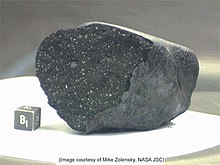Tagish Lake (meteorite)
The Tagish Lake meteorite entered the Earth's atmosphere in the early morning hours of January 18, 2000 and moved across Canada as a bright ball of fire before finally crashing into the icy Tagish Lake .
The fireball reached a brightness of −22 mag . The evaluation of satellite images showed that the original meteoroid had a mass of 200 to 250 tons and a diameter of 4 to 7 meters. This made the Tagish Lake meteorite the largest ever observed meteorite fall in Canada. The entry speed was estimated at 15 to 16 km / s. Its origin is probably in the asteroid belt .
The hundreds of found fragments, weighing several kilograms in total and in good condition, have high proportions of carbon , sulfur and nitrogen and their composition resembles a comet's nucleus . In addition, they contain an unusually large number of so-called nanodiamonds , which could have been formed by a supernova before the formation of the solar system . However, no amino acids were found that are considered to be the building blocks of life on earth.
The Tagish Lake meteorite is classified as a CI meteorite from the group of carbonaceous chondrites . These are primitive carbonaceous meteorites. The age of the meteorite is estimated at 4.5 billion years. It is thus a testimony from the early days of the solar system.
See also
Web links
- Doris Unbehaun: The Tagish Lake Meteorite! ( Memento of February 21, 2008 in the Internet Archive ) June 7, 2000
- Andrea Naica-Loebell: The Tagish Lake meteorite contains almost no amino acids. April 17, 2001
- P. Brown, DO ReVelle, AR Hildebrand: The Tagish Lake Meteorite Fall: Interpretation of fireball physical characteristics. (PDF, English; 8.36 MB)
- Tagish Lake Meteorite (English)
